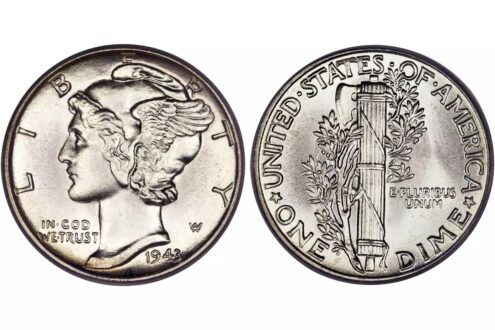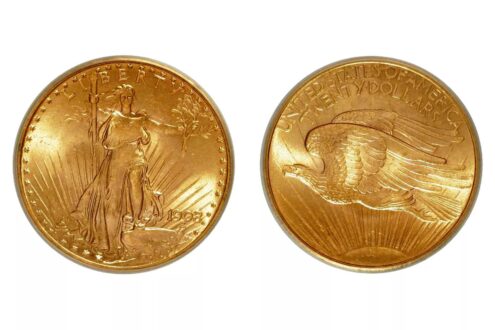- Empty cart.
- Continue Shopping
Describe the top 10 antique coin

01 of 10
1909-S V.D.B. Lincoln Cent

In 1909, the United States changed the plan of the one-penny coin from the Indian Head to a plan that celebrates the 100th commemoration of President Abraham Lincoln’s introduction to the world. The coin was a moment accomplishment with people in general. In any case, Victor David Brenner put his three initials on the opposite of the penny close to the base. Past creators just utilize their last starting, and mint fashioner Charles Barber protested this recent fad. After the United States Mint office at San Francisco created 484,000 new Lincoln pennies, the initials on the converse were taken out. This adjustment of the plan made a moment shortage.
Some might contend that the 1909-S VDB Lincoln Cent is the most famous U.S. coin. Many currency authorities start their mint piece gathering venture by gathering Lincoln pennies. Given its shortage, the 1909-S VDB is the “Sacred goal” of Lincoln pennies. This uncommon mint piece is typically the last currency Lincoln penny authorities will add to their assortment.
Optimal Collecting Grade: EF-40
Optimal Investment Grade: MS-65
02 of 10
1921 Peace Dollar

Anthony DeFrancisci planned the Peace silver dollar, and it was first delivered in December 1921. The United States Mint additionally delivered a significant mintage of 1921 dated Morgan silver dollars. The plan to remember the harmony that followed the “Incomparable War” was first proposed by Farran Zerbe, previous President of the American Numismatic Association from 1908 to 1910. The thought got on, and DeFrancisci created a lovely plan meaningful of freedom on the front-side and harmony represented by an American Eagle on the converse.
The main Peace silver dollar coins printed in 1921 had a high help however were too hard to even think about striking appropriately. The openings of the passes on were excessively profound such that the metal couldn’t stream into these profound breaks totally and caused an absence of detail on the coins. The mint didn’t start striking these coins until December 26, 1921. This poor start gave a very restricted time for the United States Mint to deliver these new dollars.
Optimal Collecting Grade: MS-63
Optimal Investment Grade: MS-65
03 of 10
1878-CC Morgan Silver Dollar

In 1878, the United States Congress passed the Bland-Allison Act that necessary the U.S. government to buy enormous amounts of silver and transform it into silver dollars. Etcher George T. Morgan at first made this plan to be utilized on a half dollar. It was ultimately changed and adjusted for the silver dollar starting in 1878. The United States Mint was burned-through totally by creating silver dollars to satisfy the necessities of the Bland-Allison Act.
Albeit the 1878-CC Morgan silver dollar is definitely not a key date nor scant with around 2,000,000 pieces printed in the Carson City, the Nevada branch mint office, possessing one of the early currencies delivered at the Carson City mint added character to any mint piece assortment. Circled pieces are decently estimated OK for the spending plan a starting gatherer. Uncirculated pieces are additionally acceptable for the spending plan of a moderate authority.
Optimal Collecting Grade: MS-63
Optimal Investment Grade: MS-65 DMPL
04 of 10
1914-D Lincoln Cent

Although not as scarce as the 1909-S VDB Lincoln cent, the 1914-D coin comes in a close second with a mintage of 1,193,000 coins produced. What makes this coin desirable is that uncirculated specimens were not saved in the same quantities that the 1909-S VDB coins were. Therefore, uncirculated 1914-D examples are scarcer than the more popular 1909-S V.D.B. coins.
Given the popularity of Lincoln cents among coin collectors, this coin has also maintained its value over time, especially for intermediate and expert collectors seeking a quality uncirculated coin. However, circulated specimens are also within the coin collecting budget of beginning and intermediate coin collectors. Be careful when selecting a circulated specimen. Look for a coin that is evenly toned and does not have any problems such as scratches or dings.
Optimal Collecting Grade: EF-40
Optimal Investment Grade: MS-63
05 of 10
1955/55 Doubled Die Lincoln Cent

The 1955 Doubled Die Lincoln penny is another mint piece that is very well known among Lincoln penny gatherers. Albeit this is viewed as a blunder currency, numerous authorities actually try to add one to their assortment. This coin is without a doubt the most well known blunder coin at any point delivered by the United States Mint.
The story of this blunder coin started when the United States Mint utilized a coin bite the dust that got two impressions that were marginally counterbalanced from one another. Mint laborers found the mistake after around 20,000 to 24,000 coins were at that point blended in with a clump of appropriately delivered coins. The mint concluded that it was not worth the cost to dissolve the whole amount of coins to scrap the mistake coins that got blended in.
At the point when information on this blunder coin started showing up in nearby papers in the northeastern United States, many individuals hauled the coins unavailable for general use. Nearby currency shops were getting them as quick as possible find them. There are numerous Uncirculated and About Uncirculated models that can be gotten for your assortment.
Shockingly, this is additionally one of the most duplicated coins available. A large number of these great fakes start from China. Be careful about any coins that you buy on eBay or, for that reality, any dealer that is obscure to you. The most ideal way of putting resources into coins is to assemble a relationship with a confided-in coin vendor.
Optimal Collecting Grade: MS-62BN
Optimal Investment Grade: MS-65RB
06 of 10
1937-D 3 Legged Buffalo Nickel

The 1937-D Three-Legged Buffalo nickel is another mistake currency that turned out to be exceptionally well known with authorities. Since its getting late and cost to created coin kicks the bucket, many passes on were cleaned or ground to broaden their bite the dust life. An exuberant mint representative ground the outer layer of the pass on to where it eliminated the subtleties for the front leg of the Buffalo on the opposite of the coin.
This coin didn’t promptly get the ubiquity and newsworthiness of the 1955 Doubled Die Lincoln penny. Accordingly a larger part of these coins saw course. Generally middle and progressed authorities of Buffalo Nickels will need to add one to their assortment. Flowed models are tolerably evaluated, yet uncirculated models are scant and just mint piece gatherers with a profound enough pocket will actually want to manage the cost of one.
It is exceptionally simple for deceitful coin vendors to take an ordinary 1937-D Buffalo Nickel and eliminate the front leg. Search for scratches or cleaning marks where the leg used to be.
Optimal Collecting Grade: EF-40
Optimal Investment Grade: MS-63
07 of 10
1916-D Mercury Dime
 Another coin that was essential for the “American Renaissance of American Coinage” in 1916 was the Mercury dime. Albeit the legitimate name for this coin is the “Winged Liberty Head Dime,” the public idea that the woman with wings on her head was the Roman god Mercury. Creation of this coin at the Denver mint in 1916 yielded just 264,000 coins. This promptly made the coin exceptionally uncommon. Combined with the notoriety of the new plan, just transitional and progressed authorities will actually want to bear the cost of one of these mint pieces for their assortment.
Another coin that was essential for the “American Renaissance of American Coinage” in 1916 was the Mercury dime. Albeit the legitimate name for this coin is the “Winged Liberty Head Dime,” the public idea that the woman with wings on her head was the Roman god Mercury. Creation of this coin at the Denver mint in 1916 yielded just 264,000 coins. This promptly made the coin exceptionally uncommon. Combined with the notoriety of the new plan, just transitional and progressed authorities will actually want to bear the cost of one of these mint pieces for their assortment.
Optimal Collecting Grade: F-12
Optimal Investment Grade: AU-53
08 of 10
1917 Standing Liberty Quarter: Type 1

The Standing Liberty Quarter was first created in 1916 with an extremely restricted mintage. Along these lines, the 1916 Standing Liberty quarter is amazingly uncommon and costly. Thusly, the second year of creation in 1917 is a more reasonable illustration of an exemplary United States coin.
The Type 1 coin highlights Lady Liberty with her allowed bosom to remain uncovered. Certain individuals accept shock started by the general population caused the United States Mint to create a second kind of coin with Lady Liberty’s chest covered by a layer of networking mail. Another hypothesis is that the United States was getting ready for entrance into World War I in 1917 and the layer of networking mail was added to demonstrate that Lady Liberty was prepared for the fight to come. Circled instances of this mint piece are reasonable for even the starting authority. A moderate mint piece authority can without much of a stretch get uncirculated models.
Optimal Collecting Grade: MS-65
Optimal Investment Grade: MS-67FH
09 of 10
1932-D Washington Quarter

The Washington quarter first produced in 1932 and was intended to be a one-year commemorative coin to commemorate the 200th anniversary of George Washington’s birth. Due to the Great Depression, no Washington quarters were produced in 1933. However, the issue proved to be so popular that the design was permanently adopted in 1934 and is still in use to this date.
The 1932-S Washington quarter has a lower mintage than the 1932-D, but more of them were saved and are readily available and higher grades. The 1932-D quarter is scarce and will prove to be a better addition to your coin collection and most probably will appreciate better than the San Francisco issue.
Optimal Collecting Grade: AU-53
Optimal Investment Grade: MS-64
10 of 10
1908 St. Gaudens Arabic Numerals No Motto

The United States Mint previously printed the Saint-Gaudens $20 gold coin in 1907. The primary coins were made in super high alleviation yet demonstrated too hard to even think about striking effectively and didn’t stack flawlessly for financiers. Etchers at the mint brought down the alleviation in 1908 and coins were promptly made for creation. Most numismatists concur that the Saint-Gaudens $20 gold coin is the most excellent coin at any point made by the United States Mint.
At first, the adage “IN GOD WE TRUST” was excluded from the first plan by Augustus Saint-Gaudens. The plan was altered toward the finish of 1908 to remember the proverb for the opposite of the coin. This “No Motto” mint piece is accessible at an unobtrusive cost considering a gold currency will enhance any mint piece assortment.
Optimal Collecting Grade: MS-66
Optimal Investment Grade: MS-67






